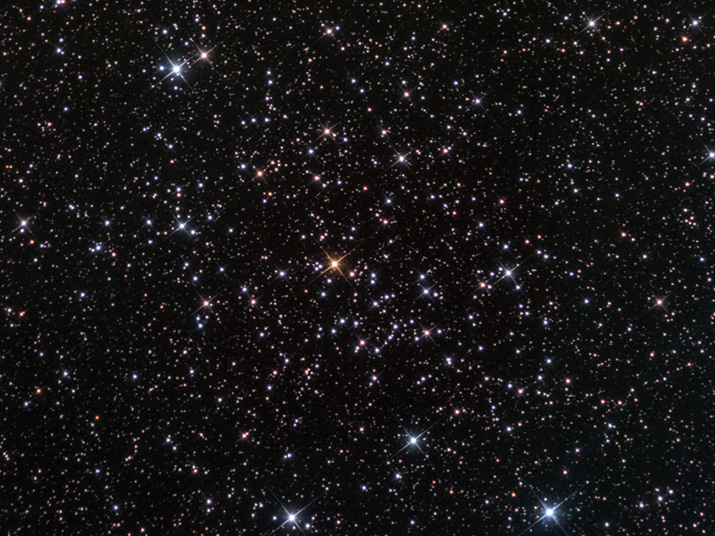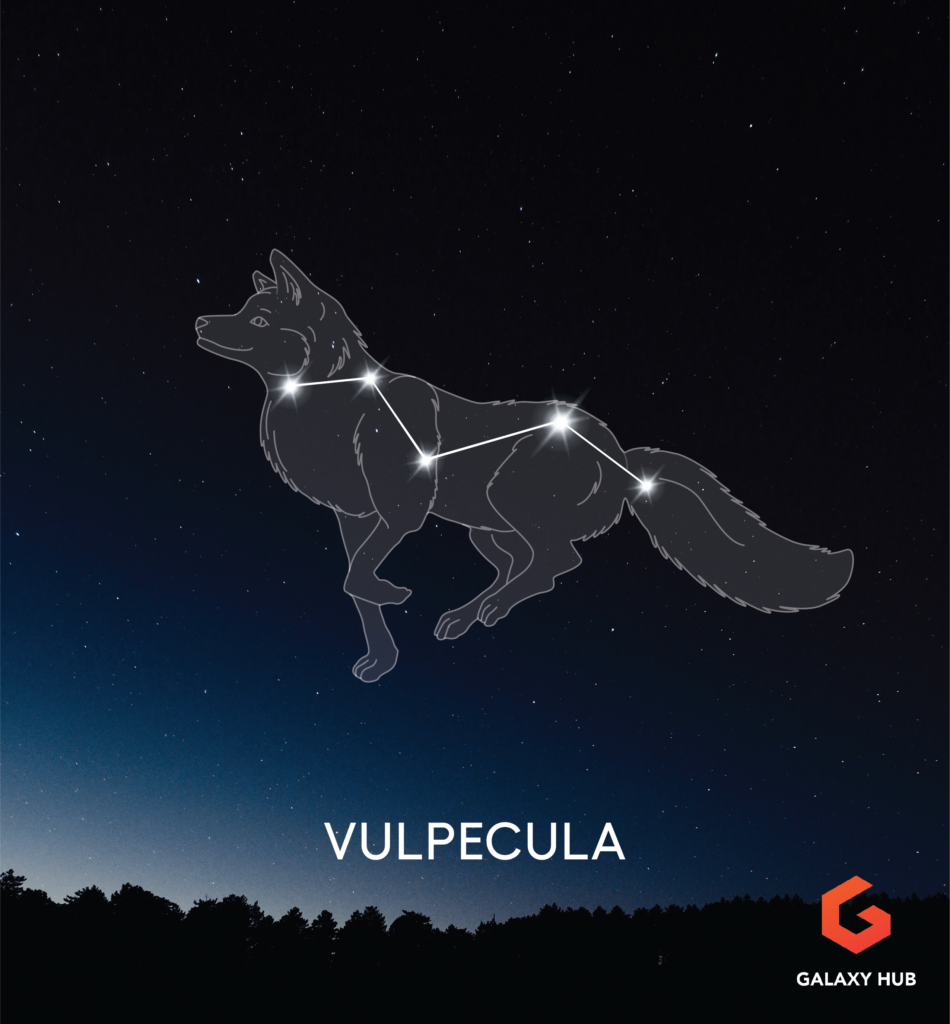
Vulpecula didn’t even exist until the 17th century, and was only created to fill the gap between Cygnus and Sagitta.
As such, it’s not a bright or well-known constellation and if it wasn’t for the presence of Messier 27, the Dumbbell Nebula, and Collinder 399, the Coathanger, there really wouldn’t be much of interest at all.
Fortunately, while the stars of Vulpecula are faint, both those celestial sights are relatively easily found and well worth seeking out.
Otherwise, there is a small handful of open star clusters, while Anser, the constellation’s brightest star, is an easy double for binocular observers.
Vulpecula is best seen from mid to late summer, but remains visible during the early autumn months.
Vulpecula – Key Data
Name
| Latin | English | Pronunciation | Genitive | Abbreviation |
| Vulpecula | The Fox | vul-PECK-yuh-luh | Vulpeulae | Vul |
Location
| Hemisphere | Best Seen | R.A. | Declination |
| Northern | Late July to Mid September | 20h 20m 59s | +25° 04’ 18” |
Features
| Area | Size Rank | # of Messier Objects | # of Stars Brighter than Mag 4 | Brightest Star |
| 268 sq. Deg. | 55th | 1 | 0 | Alpha (Anser) Mag 4.4 |
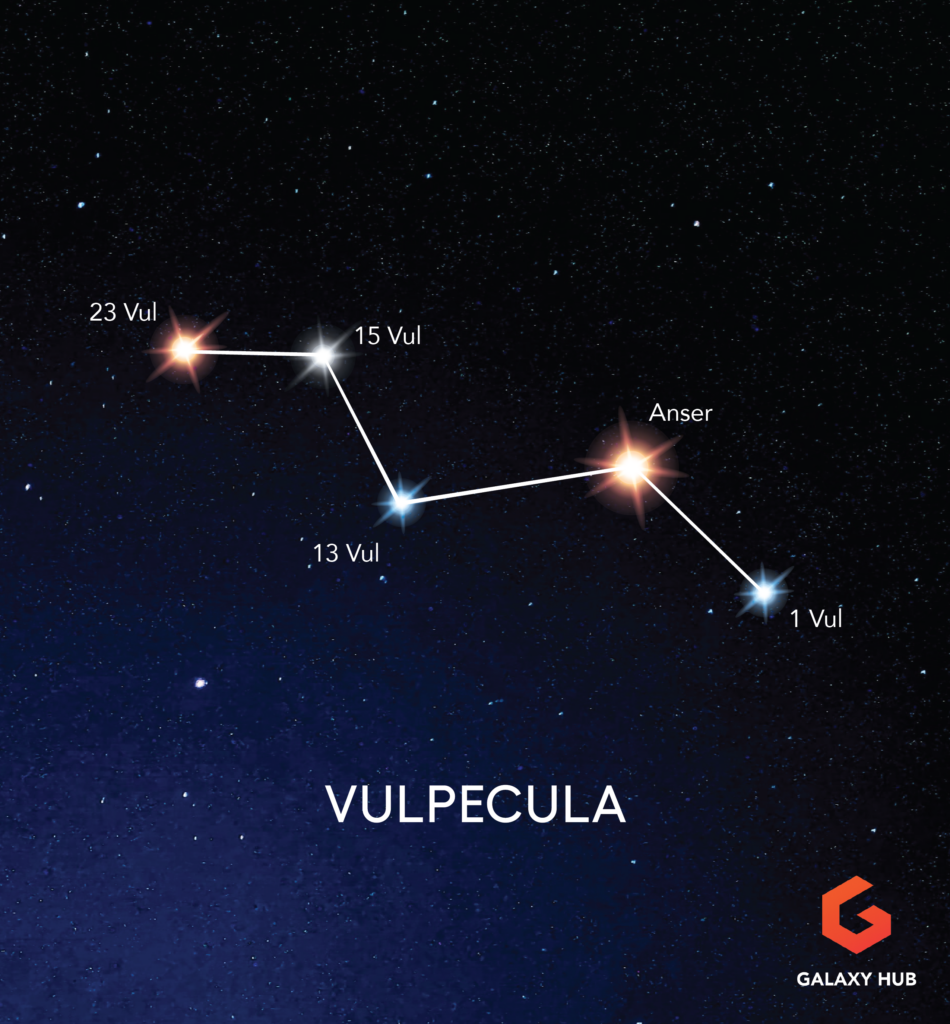
Top Vulpecula Facts
- It was invented by Johannes Hevelius late in the 17th century.
- It’s faint, with no stars brighter than magnitude four.
- The name of its brightest star, Anser, means “goose,” and is a hold-over from the original name of the constellation, Vulpecula cum Anser.
- It contains one Messier object, M27, the Dumbbell Nebula.
- The Coathanger asterism has been known for thousands of years and was once thought to be a star cluster.
Vulpecula in Mythology
Vulpecula is a modern constellation (see below), with no known ties to any pre-existing myths or legends.
Vulpecula in History
Vulpecula was invented in the late 17th century by the Polish astronomer Johannes Hevelius.
As with many of the modern nothern constellations, its stars are faint and the constellation was invented solely for the purpose of filling the gap between Cygnus the Swan and Sagitta the Arrow.
Hevelius originally named the constellation Vulpecula cum Anser – the Fox and the Goose – as he believed both were “rapacious and greedy,” like neighboring Aquila, the Eagle.
As such, the constellation was often depicted as a fox carrying a goose in its jaws, but over time the goose became forgotten. This left the fox alone, but one telltale reminder of the goose remains, as the name Anser (“the goose”) is now the name of the constellation’s brightest star.
When & How to See Vulpecula
Since the constellation is relatively faint, you might think that it’s also difficult to find, but that’s not actually the case. As long as you can identify Cygnus, the Swan, you’ll have no problem locating Vulpecula.
At the very least, you should be able to pick out Anser, the brightest star. That said, if you live under light-polluted skies, you’ll most likely need to wait for your eyes to properly adapt to the dark first.
It’s best seen between 11pm and midnight around the middle of August, when the constellation is over the southern horizon and reasonably high in the sky for nothern hemisphere observers.
You’ll first need to locate Deneb, the brightest star in Cygnus, and then trace the outline of the constellation toward the south until you come to Albireo.
Deneb marks the tail of the swan, while Albireo marks its head. (If you have a telescope, take a moment to enjoy Albireo, as it’s a beautiful double star of gold and sapphire blue.) Just 3.3 degrees to the south of Albireo is Anser.
The first time you look for it, you might want to use binoculars to help you locate it.
You’ll be able to easily spot it, as it’ll appear within the same field of view as Albireo and appears double, with the primary star being about three times brighter than its companion.
Vulpecula’s Notable Stars
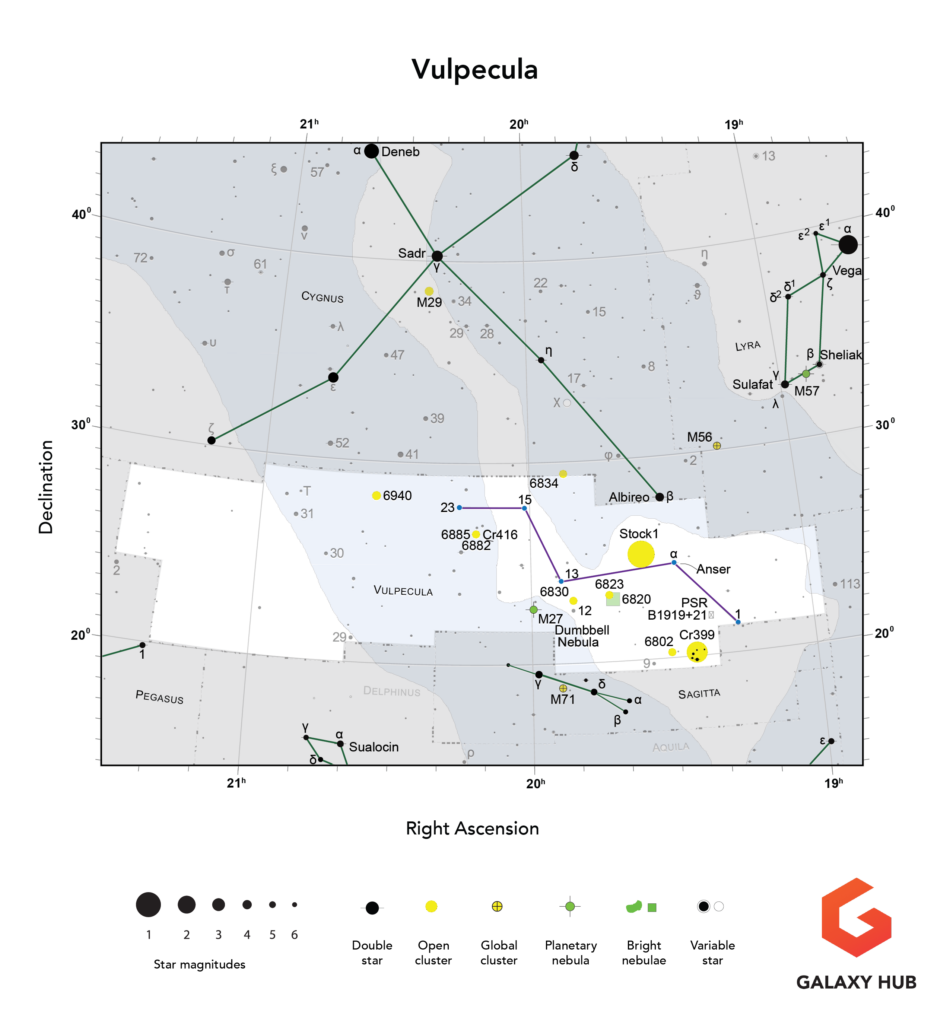
| Bayer/Flamsteed Designation | Name (s) | Mag | R.A. | Dec. | Distance (LY) | Notes |
| Alpha / 6 | Anser | 4.4 | 19h 29m 40s | +24° 42’ 41” | 297 | Vulpecula’s brightest star and a binocular double |
| N/A / 23 | 4.5 | 20h 16m 43s | +27° 53’ 02” | 340 | 2nd brightest star | |
| N/A / 13 | 4.6 | 19h 54m 26s | +24° 08’ 19” | 330 | 3rd brightest star. |
Alpha Vulpeculae (Anser)
Besides being Vulpecula’s bright star, Anser’s primary claim to fame is its name. Before the invention of the constellation itself, the star had no name – most likely because it was too faint to garner much attention.
Once the constellation became accepted, astronomers shortened its name from its original Vulpecula cum Anser (the Fox and the Goose) to just Vulpecula. Alpha Vulpeculae then adopted the name Anser, thereby allowing the goose to live on.
Anser is easily found, lying just a little more than three degrees to the south of Albireo, in Cygnus. Take a look with binoculars and you’ll notice a fainter star, 8 Vulpeculae.
This is an unrelated star, roughly 80 light-years closer to us. The pair make for an easy target in binoculars, but their comparatively wide separation and lack of brightness make them visually unappealing through telescopes.
Anser itself is a class M0III giant. In comparison with the Sun, it’s 1.5 times more massive, 400 times more luminous and has a radius 50 times that of the Sun.
It’s a reddish, relatively cool star, and at an age of 11 billion years old, it’s nearing the end of its life, with a dead core that will eventually fuse to carbon.
Anser, however, may have had an interesting past, as it’s thought it may have once been a member of a small galaxy consumed by the Milky Way.
23 Vulpeculae
The constellation’s second brightest star, 23 Vulpeculae, is a triple star system approximately 327 light-years away, but unfortunately, these stars are too close together to be seen visually.
Component A forms a binary pair that orbit one another every 25 years, with the third member of the system orbiting this pair at a distance of roughly ten times the distance from the Earth to the Sun.
13 Vulpeculae
The third brightest star in the constellation, 13 Vulpeculae, is a double star system nearly 340 light-years away. The primary star is a B9 blue giant, with a luminosity roughly 180 times that of the Sun.
Not much is known of its companion, except that it’s separated from the primary by a distance of 147 AUs, with the pair taking 615 years to orbit one another.
Vulpecula’s Asterisms
| Object | Name(s) | Avg. Mag | R.A. | Dec. | Min. Equipment |
| Cr 399 | The Coathanger Al Sufi’s Cluster Brocchi’s Cluster |
3.6 | 19h 26m 24s | +20° 13’ 41” | Binoculars |
Collinder 399 – The Coathanger
If you live under dark skies, you may be able to glimpse Collinder 399 with the naked-eye.
As such, it’s been known to astronomers for thousands of years, and has garnered a number of names in that time. It was first mentioned by the Persian astronomer Al Sufi in 975 A.D., thereby giving the group its first name: Al Sufi’s Cluster.
Another name, Brocchi’s Cluster, comes from the 1920’s, when the amateur astronomer Dalmero Frances Brocchi mapped the stars for the American Association of Variable Star Observers.
Its third name, the Coathanger Cluster, came from its shape when observed with binoculars, or through a telescope at a very low magnification.
Regardless of whether you call it Al Sufi’s Cluster, Brocchi’s Cluster or the Coathanger Cluster, all these names are inaccurate, as this is not a true cluster at all.
Studies by the Hipparcos satellite in the late 1990’s demonstrated that the stars were unrelated, and their close appearance to one another is merely a chance alignment. In reality, the stars are hundreds of light-years apart.
As such, it’s technially an asterism, and many astronomers now refer to it simply as “the coathanger.”
If you take a look for yourself, you’ll see a slightly crooked line of six stars, with the misshappen hook formed by another four.
All the stars are roughly the same brightness, with the magnitude averaging out at around six. The hook is slightly brighter, with the brightest star in the group (4 Vulpeculae) shining at magnitude 5.2 at the top of the hook.
It’s easily found, as it appears within the same 10×50 binocular field of view as Anser, just four and a half degrees to the star’s south. (Just be aware that the coathanger appears upside down from the northern hemisphere.)

Vulpecula’s Deep Sky Objects
| Object | Name(s) | Type | Mag | R.A. | Dec. | Distance (LY) | Min. Equipment |
| M27 | The Dumbbell Nebula | Planetary Nebula | 7.1 | 20h 00m 37s | +22° 46’ 50” | 1,400 | Binoculars |
| NGC 6823 | N/A | Open Cluster | 7.1 | 19h 44m 09s | +23° 21’ 18” | 10,000 | |
| NGC 6830 | N/A | Open Cluster | 7.9 | 19h 52m 00s | +23° 09’ 33” | 5,300 | |
| NGC 6885 | N/A | Open Cluster | 8.1 | 20h 13m 00s | +26° 32’ 11” | 1,900 | |
| NGC 6940 | N/A | Open Cluster | 6.3 | 20h 35m 25s | +28° 21’ 49” | 2,500 |
Nebulae
M27 – The Dumbbell Nebula (Planetary Nebula)
One of the brightest planetary nebulae in the sky, the Dumbbell Nebula is a popular target with both visual observers and astroimagers alike.
You can find it by first locating Anser and then moving east 5.7 degrees to 13 Vulpeculae, the constellation’s third brightest star. M27 appears within the same 10×50 binocular field of view as 13 Vul, just under two degrees to the southeast.
Unfortunately, it’s likely to elude you if your location suffers from light pollution, but it’s bright enough to be seen under reasonably dark skies.
Binoculars will show a very faint, circular misty patch, with the nebula being much more easily seen through a telescope at low power.
Through a small telescope, the two lobes that give the nebula its name appear large and bright, and help to give the nebula an almost rectangular shape. Using averted vision can help to bring out some details, with filaments reaching out toward the north and south. The nebula also responds well to using an OIII filter.
The Dumbbell was discovered by Charles Messier in July 1764. He described it as being oval and lacking a star, but he wasn’t aware of its true nature as it was the first of its kind to be discovered.
In reality, the Dumbbell is the shell of gas and dust thrown off by a dying star nearly 10,000 years ago. It’s now expanded to a diameter of about one light-year, with an estimated distance of roughly 1,400 light-years.
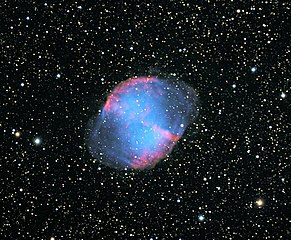
Star Clusters
NGC 6823 (Open Star Cluster)
A small and sparse cluster, found within the same binocular field of view as both 13 Vulpeculae and M27, or alternatively, Anser and the Coathanger. You’ll most likely need higher power binoculars to spot it, with the cluster best observed telescopically at moderately high magnificaiton.
Averted vision will help to bring out the stars, which appear of unequal brightness, with a tiny group of stars at its center.
There’s a nebula associated with the cluster (NGC 6820), but this is difficult to be be seen visually, requiring a large scope, a filter and dark skies.
NGC 6823 is 10,000 light-years away and about 18 light-years in diameter, with an estimated age of around 3 million years.
NGC 6830 (Open Star Cluster)
NGC 6830 is another open star cluster that appears within the same binocular field of view as 13 Vulpeculae and the Dumbbell Nebula.
Like its neighbor NGC 6823, this is a sparse cluster that’s detectable with binoculars but really needs a telescope to make the most of it. Scopes of around 150mm will show roughly 25 stars, with the brightest forming a noticeable X shape.
NGC 6830 lies at a distance of about 5,300 light-years, has an estimated diameter of 8 light-years and is thought to be about 37 million years old.
NGC 6885 (Open Star Cluster)
Remaining within the same binocular field of view as 13 Vulpeculae, we find the open star cluster NGC 6885.
It lies 4.8 degrees to the star’s northeast and is surrounds 20 Vulpeculae, a magnitude 5.9 star that outshines the cluster itself. It’s a loose, triangular cluster, with around 40 stars being visible through a mid-sized scope.
NGC 6885 is nearly 2,000 light-years away, roughly 11 light-years in diameter and has an estimated age of 1.5 billion years.
NGC 6940 (Open Star Cluster)
The brightest of Vulpecula’s notable clusters, NGC 6940 lies close to the border with neighboring Cygnus and can be found 6.2 degrees southwest of the star Gienah (Epsilon Cygni).
Look for 41 Cygni, a magnitude 4.0 star, that appears about three-quarters of the way from Gienah and to the northwest of NGC 6940.
This is a rich, dense cluster, detectable in binoculars but comprised of faint stars, thereby requiring a telescope for the best views.
There are about 100 stars here, of relatively equal brightness, but a little unevenly dispersed across the cluster. In particular, look out for the orange-red variable star RG Vulpeculae and a line of stars running through the center.
NGC 6940 is 2,500 light-years away, around 18 light-years in diameter and roughly 700 million years old.
